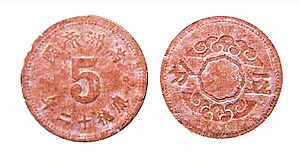Manchukuo yuan facts for kids
The Manchukuo yuan was the official money used in the Empire of Manchukuo. This country existed from 1932 to 1945. The Manchukuo yuan was used from June 1932 until August 1945.
At first, one Manchukuo yuan was worth 24 grams of silver. This new money replaced an older Chinese money called the tael. The tael was commonly used in Manchuria. One tael was worth about 40 grams of silver.
Contents
How the Manchukuo Yuan Changed
When the Manchukuo yuan was first created in 1932, it was linked to the value of silver. This meant its value depended on how much silver was worth.
Linking to the Japanese Yen
Over time, the price of silver changed a lot. Because of this, the yuan could no longer always buy 24 grams of silver. To keep its value stable, the Manchukuo yuan was then linked to the yen. The yen was the money used in Japan. This link helped the yuan stay strong.
Yuan in World Trade
By 1940, the Manchukuo yuan was important for trade. It was used to measure how much Manchukuo exported (sold) and imported (bought). This trade happened with countries like America, Germany, and Japan.
What Did the Manchukuo Yuan Look Like?
The Manchukuo yuan came in different forms. Most of it was paper money, but there were also coins.
Paper Money Notes
In 1932, there were five different values of paper money, also called notes. These included:
- A one hundred yuan note
- A ten yuan note
- A five yuan note
- A one yuan note
- A small value note
Later, in 1944, a very large 1000 yuan note was also made.
The paper notes had pictures of Chinese emperors on them. At first, this money was printed in Japan. Later, it was made by the Bank of Manchukuo. This bank was located in the capital city of Hsinking. Today, Hsinking is known as Changchun.
Coins and Their Values
The yuan was divided into smaller units. These were:
- 10 chiao made one yuan.
- 100 fen made one yuan.
- 1000 li made one yuan.
Coins were made for smaller values. The smallest coin was worth 5 li. The largest value coin was 10 fen.
Unusual Cardboard Coins
In 1944 and 1945, Manchukuo made some very unusual coins. These coins were made from red or brown cardboard! It's rare to find coins made from cardboard. Even though they are unique, these cardboard coins are not extremely hard to find today.
What Happened to the Manchukuo Yuan?
The Manchukuo yuan stopped being used after World War II.
On January 1946, the Manchukuo yuan was replaced. The Chinese government allowed people to exchange their Manchukuo yuan. One Manchukuo yuan could be swapped for a new type of money called a North-Eastern Yuan.
Later, in 1948, these new North-Eastern Yuans were also replaced. People could swap them for a Gold Yuan. However, the exchange rate was very different. One Gold Yuan cost 150,000 North-Eastern Yuans!
Images for kids
See also
 In Spanish: Yuan de Manchukuo para niños
In Spanish: Yuan de Manchukuo para niños





